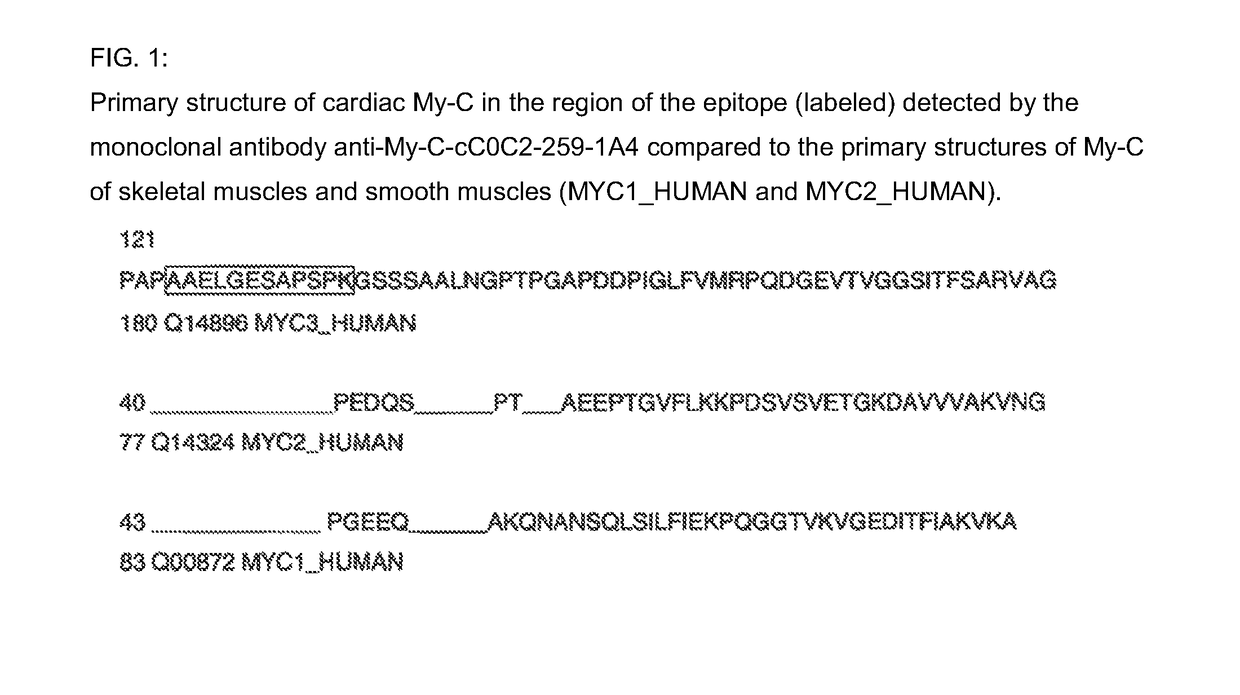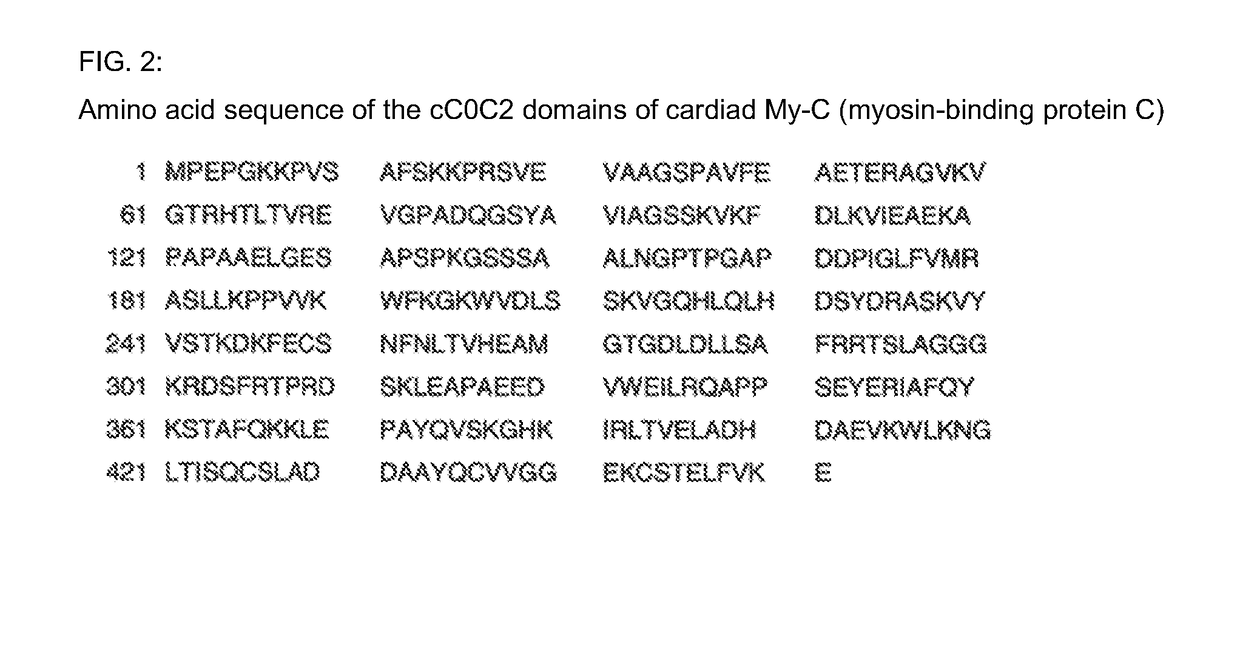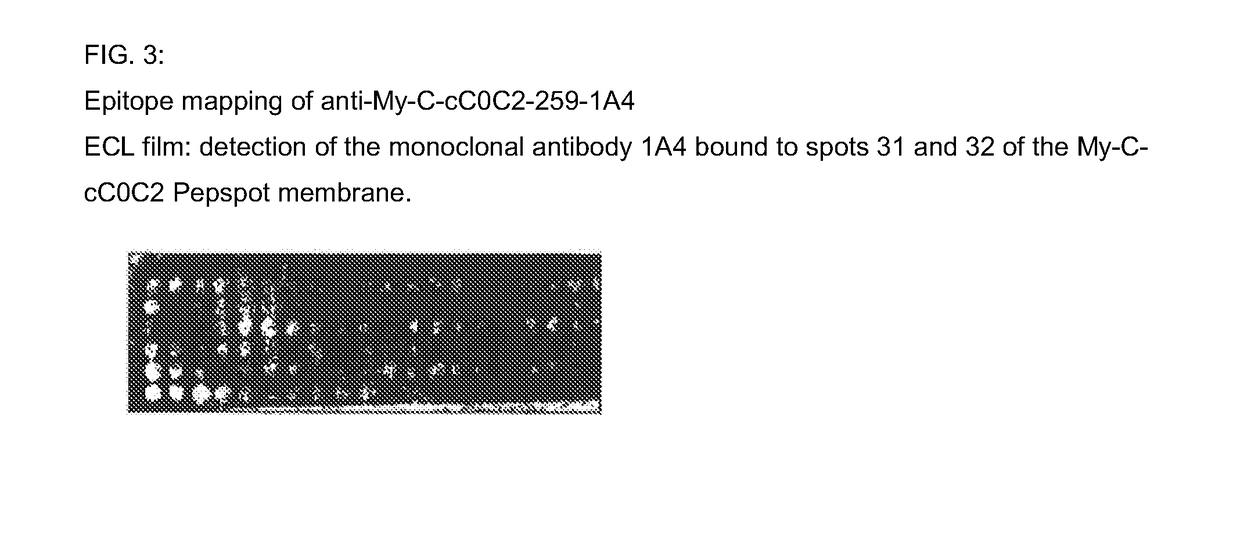Hybridoma cell lines (My-C-cC0C2-259-1 A4) and use thereof for producing a monoclonal antibody against human cardiac myosin binding protein C (C-protein, MYBPC3, cMyBP-C or My-C)
a hybridoma and antibody technology, applied in the field of mouse hybridoma clone producing a monoclonal antibody (myccc22591a4), can solve the problems of inability to detect low ctn concentrations in the first hours after symptoms begin to manifest, lack of analytical sensitivity for detecting low ctn concentrations in the first hours, etc., and achieve the effect of early diagnosis of cardiac infarction
- Summary
- Abstract
- Description
- Claims
- Application Information
AI Technical Summary
Benefits of technology
Problems solved by technology
Method used
Image
Examples
example 1
Production of the Hybridoma Cell Line
[0030]The spleen of a mouse immunized in the known manner with cC0C2 of the My-C is removed under sterile conditions, and the spleen cells are flushed out of the spleen capsule using RPMI 1640 medium (LIFE TECHNOLOGIES™, Karlsruhe) with a syringe and isolated. The spleen cells are pelletized (10 minutes at 300.times.g), washed three times with RPMI 1640 medium, and resuspended in RPMI 1640 medium. They are then fused with myeloma cells of the line P3X63Ag8.653 (ATTC CRL 1580). For this purpose, cultivated myeloma cells, which are in the log phase of growth, are likewise pelletized and washed three times. 1×108 spleen cells and 5×107 myeloma cells are pipetted into a centrifuge tube, mixed intensively and centrifuged; 1.5 ml preheated 50% polyethylene glycol 1500 (Roche, Basel) is added dropwise to the cell sediment within one minute, while the tubule is continuously rotated at 37° C. The fusion batch is then incubated for another minute at 37° C....
example 2
Selection of the Antibody-Producing Clones
[0031]All growing clones or the antibodies thereof were tested for reactivity using an enzyme-linked immunosorbent assay (ELISA). The immunosorbent was the immunogen, this being the recombinant cC0C2 domain of the My-C (approximately 2 μg / ml).
[0032]Carrying out the ELISA:[0033]1. Coat each of the microtiter plates (Costar, high binding) with 50 μl immunogen solution per well at 4° C. over night;[0034]2. wash the microtiter plates (MTP) 3 times with Tris-buffered saline (TBS), pH 7.4;[0035]3. block the MTP using 200 μl blocking reagent (Boehringer, Mannheim) per well, 1 hour at 37° C.;[0036]4. wash the MTP 3 times with NaCl Tween 20;[0037]5. incubate with culture supernatant of the hybridoma cultures; 50 μl per well, respectively, diluted approximately 1:2 with TBS Tween 20;[0038]6. wash the MTP 3 times with NaCl Tween 20;[0039]7. incubate with anti-mouse Ig antibodies, coupled to peroxidase, 50 μl per well, 1 hour at room temperature;[0040]8...
example 3
Epitope Mapping for the Monoclonal Antibody 1A4 in the Human Cardiac My-C
[0043]The binding site of the monoclonal antibody 1A4 was identified by way of the peptide scanning method. For this purpose, the entire amino acid sequence of the human cC0C2 domain of the My-C that was used for the immunization is divided into a total of 111 overlapping amino acid sequences, each having a length of 15 amino acids. These sequences are synthesized as individual peptides in spots directly on a cellulose membrane. The membrane is incubated with the antibody-containing culture supernatants of the hybridomas, and the binding sites of the antibodies are rendered visible by way of incubation with a peroxidase-coupled anti-mouse Ig antibody. For this purpose, after washing three times with TBS Tween, the membrane is placed between copy film, and then incubated for 3 minutes with the ECL™(enhanced chemiluminescent) detection reagent (Amersham, Braunschweig). An applied film (HYPERFILM ECL™ [RPN 2103H A...
PUM
| Property | Measurement | Unit |
|---|---|---|
| concentration | aaaaa | aaaaa |
| concentrations | aaaaa | aaaaa |
| length | aaaaa | aaaaa |
Abstract
Description
Claims
Application Information
 Login to View More
Login to View More - R&D
- Intellectual Property
- Life Sciences
- Materials
- Tech Scout
- Unparalleled Data Quality
- Higher Quality Content
- 60% Fewer Hallucinations
Browse by: Latest US Patents, China's latest patents, Technical Efficacy Thesaurus, Application Domain, Technology Topic, Popular Technical Reports.
© 2025 PatSnap. All rights reserved.Legal|Privacy policy|Modern Slavery Act Transparency Statement|Sitemap|About US| Contact US: help@patsnap.com



